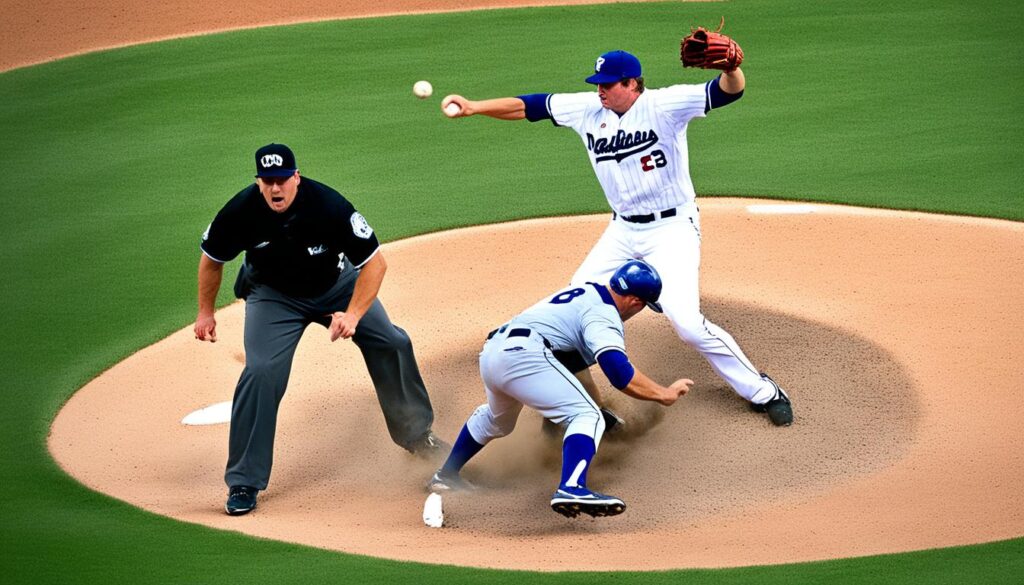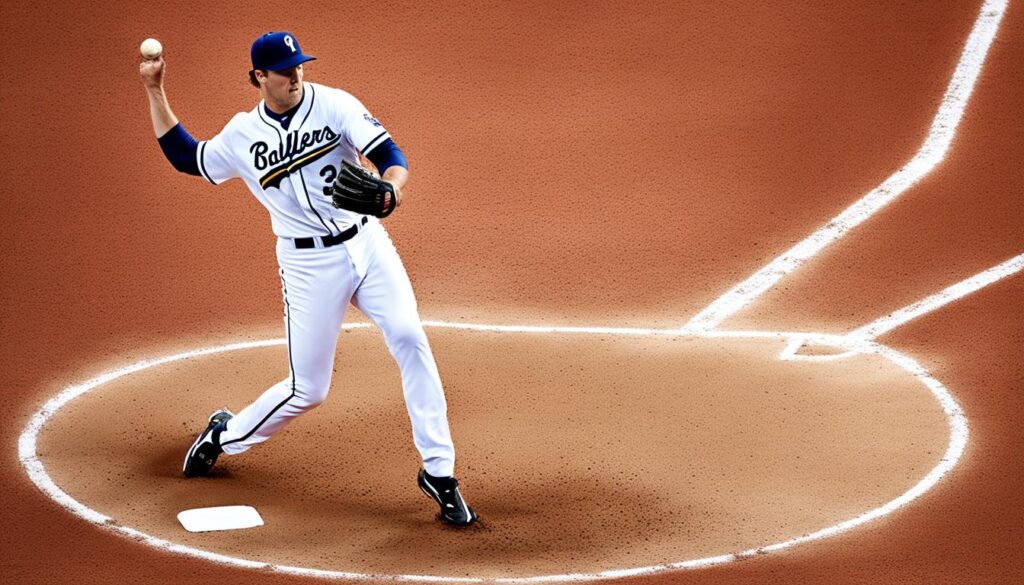
Baseball is a game full of rules and intricacies that can sometimes be confusing for both players and spectators. One rule that often leads to raised eyebrows and puzzled looks is the balk. So, what exactly is a balk in baseball? Let’s dive in and find out!
A balk occurs when the pitcher makes an illegal act with a runner or runners on base, resulting in all runners advancing one base. It can be a costly mistake that can change the course of a game. Understanding the different ways a balk can occur is crucial for pitchers and coaches to ensure fair play and avoid embarrassment.
Key Takeaways:
- A balk is an illegal act by the pitcher that results in all runners on base advancing one base.
- There are various ways to balk, such as starting and stopping, faking a throw to first base, or throwing to an unoccupied base.
- Knowing the rules surrounding balks is important to prevent mistakes and maintain fair gameplay.
- Penalties for balks include all runners advancing and the pitch being ruled a dead ball, but they do not count against a pitcher’s ERA.
- Coaches and players should work on strategies to avoid balks, such as proper pitching techniques and clear communication with base coaches.
The Official Definition of a Balk
According to the official baseball rule book, a balk is defined as “an illegal act by the pitcher with a runner or runners on base, entitling all runners to advance one base.” When a balk occurs, all runners on base move up one base, including to home if there is a runner on third. If there are no runners on base, a balk is called an “illegal pitch” and a ball is added to the count. The catcher can also cause a balk by not being in the catcher’s box.
| Balk Situation | Effect on Runners | Effect on Pitcher |
|---|---|---|
| Runner(s) on base | All runners advance one base | Balk is counted, possible ejection |
| No runners on base | Added ball to the count | Balk is counted, no ejection |
Common Ways to Balk: Starting and Stopping
One common way to balk is when a pitcher starts his pitching motion and then stops, either due to a full-blown pitch about to be thrown or a subtle flinch or movement. Flinching is often caused by unexpected situations, such as a runner stealing early or a fielder yelling at the pitcher. Any body movements that are not part of delivering the pitch, stepping off the rubber, or picking off to a base can result in a balk call.
When a pitcher begins his pitching motion but fails to complete it, it can deceive baserunners and disrupt the flow of the game. The abrupt stoppage or flinching can create confusion and an unfair advantage for the defense. Umpires closely monitor for illegal body movements that can potentially deceive baserunners or give the pitcher an unfair advantage.
“A balk can occur when the pitcher initiates the pitching motion, either towards delivering the pitch or because of an involuntary flinch, and then stops without completing the pitch.”
It’s crucial for pitchers to maintain control over their body movements and execute a smooth and consistent pitching motion to avoid the risk of a balk call. By practicing proper form and staying focused, pitchers can minimize the chances of starting and stopping balks.
The Rule on Faking a Throw to First Base
When it comes to pickoff moves and faking a throw to first base, there are specific rules that pitchers must follow to avoid committing a balk. Let’s dive into the details.
For right-handed pitchers, it is legal to perform a pickoff move to first base by disconnecting their back foot forward from the rubber. However, if they fake a throw to first without stepping off the rubber, it will be considered an illegal pickoff move and result in a balk.
On the other hand, left-handed pitchers have the ability to fake a throw to first base, but they must step back off the rubber before doing so. Faking a throw to first without stepping back will also be considered an illegal pickoff move.
These rules are in place to maintain the fairness and integrity of the game, preventing pitchers from deceiving baserunners with illegal actions.
Remember, the goal is to execute pickoff moves and throws to bases within the boundaries of the rules. By understanding and adhering to the regulations, pitchers can avoid committing illegal pickoff moves and balks, keeping the game fair for all players involved.
Throwing or Faking a Throw to an Unoccupied Base
Pitchers are not allowed to throw or fake a throw to a base that is unoccupied, except for the purpose of making a play. For example, if a runner breaks for second base, it is acceptable for the pitcher to throw to second base even if the runner turns toward first as long as it is a continuous motion toward second. However, throwing or faking a throw to an unoccupied base where there is no runner present is a balk.
It is important for pitchers to understand the rule on throwing or faking a throw to an unoccupied base to avoid penalties. The purpose behind this rule is to prevent deceptive actions by pitchers that can confuse baserunners and create an unfair advantage. By restricting pitchers from throwing or faking a throw to an unoccupied base, the rules maintain game integrity and enhance the strategic aspects of baseball.

| Throwing or Faking a Throw to an Unoccupied Base: Does it Result in a Balk? | Baserunners on Second and Third Base | No Baserunners |
|---|---|---|
| Consequences | All baserunners advance one base. | No penalty, but a ball is added to the count. |
As shown in the table above, when a pitcher throws or fakes a throw to an unoccupied base with baserunners on second and third base, all baserunners advance one base. This can have significant implications for the defense, as it may influence their positioning and overall game strategy. On the other hand, if there are no baserunners present and a pitcher throws or fakes a throw to an unoccupied base, it is considered an illegal pitch, and a ball is added to the pitch count.
Coming Set and Pause in the Stretch Position
One crucial aspect of delivering a pitch in baseball is the proper execution of the coming set and pause in the stretch position. When a pitcher comes set in the stretch position, they must pause for at least one second before delivering the pitch. This pause is essential as it ensures that the pitcher and baserunners are in sync and allows the defense to prepare for the upcoming play.
The pitcher is not allowed to simply “roll through” coming set without pausing. It is against the rules to rush through the set position and immediately proceed with the pitching delivery. The pause acts as a key element in maintaining the fairness and integrity of the game, providing time for the pitcher to assess the situation and for the runners to react accordingly.
During the pause in the stretch position, it is essential for the pitcher to avoid any body movements or flinches that may be considered erratic or deceptive. Any sudden or improper movements after accepting the pitch and when getting into the set position can lead to a balk. Therefore, it is crucial for pitchers to focus on keeping their body relaxed, maintaining a smooth and steady posture throughout the pause.
Being mentally tough is also necessary for pitchers when it comes to the coming set and pause in the stretch position. They need to stay composed and composed, even in unexpected situations that may arise during a game. By remaining calm and collected, pitchers can effectively execute the coming set and pause, minimizing the risk of committing a balk and disrupting the flow of the game.
| Key Points |
|---|
| Pause for at least one second in the stretch position before delivering the pitch |
| Avoid rolling through the set position without pausing |
| Stay relaxed and avoid any erratic or deceptive body movements |
| Maintain mental toughness to adapt to unexpected situations |
Quick Pitch and Legal Quick Pitches
A quick pitch, which is an illegal quick pitch, occurs when a pitcher throws the pitch before the batter is ready in the box. However, there are legal types of quick pitches where a pitcher can throw the pitch quickly if the batter is not expecting it. For example, a pitcher may shorten their leg kick to catch the batter off guard. It is important for pitchers to be aware of the rules surrounding quick pitches to avoid committing a balk.
When a pitcher performs a quick pitch without giving the batter adequate time to set up, it is considered an illegal quick pitch. The intent of this rule is to maintain fairness and give the batter a fair opportunity to prepare for each pitch. Pitchers must ensure that the batter is ready and has assumed their stance before delivering the ball. Failure to do so can result in the umpire calling a balk.
However, there are situations where a quick pitch can be legal. If the batter is not expecting the quick pitch and has not assumed their stance, the pitcher can take advantage of this and throw the pitch quickly. This can catch the batter off guard and potentially lead to a swing and miss or a weakly hit ball. Pitchers who can effectively execute legal quick pitches can gain an advantage over the batter.
One example of a legal quick pitch is when the pitcher shortens their leg kick. By reducing the height of their leg kick, the pitcher can deceive the batter and throw the pitch more quickly than usual. This can disrupt the batter’s timing and make it harder for them to make solid contact with the ball. However, it is important for pitchers to remember that they still need to wait for the batter to assume their stance before starting their delivery.

What Constitutes a Balk and Its Origin
In 1898, baseball introduced rules against balks, aiming to prevent pitchers from intentionally deceiving baserunners. The term “balk” finds its roots in old English games like rounders and cricket, where it signified a violation of specific foot movement rules. In the context of baseball, a balk is called when a pitcher’s movement is deemed deceitful to the baserunner(s). If an umpire notices any illegal movement by the pitcher, they can call a balk, resulting in consequences for the pitcher and advancement for the baserunners.
Understanding what constitutes a balk is crucial for both pitchers and baserunners to avoid confusing situations and ensure fair play. It is essential for pitchers to maintain a consistent and legal pitching motion, free from deceptive actions that may mislead the baserunners. Similarly, baserunners should be aware of the pitcher’s movements to determine whether a balk has occurred, allowing them to take advantage of any advances they are entitled to.
Let’s take a closer look at the common ways pitchers can commit a balk and the strategies to prevent baserunner deception:
- Starting and Stopping: One common type of balk occurs when a pitcher starts the pitching motion but suddenly stops, causing confusion and providing an advantage to baserunners.
- Faking a Throw to First Base: Pitchers must be cautious with their pickoff moves to first base. Faking a throw without stepping off the rubber can result in a balk, affecting the game’s dynamics.
- Throwing or Faking a Throw to an Unoccupied Base: Pitchers should exercise caution when throwing or faking a throw to an unoccupied base. Doing so without a specific purpose can lead to a balk being called.
- Coming Set and Pause in the Stretch Position: When a pitcher comes set in the stretch position, they must pause for at least one second before delivering the pitch. Failure to do so can result in a balk.
- Quick Pitch and Legal Quick Pitches: Pitchers must understand the rules surrounding quick pitches to avoid committing a balk while maintaining control and speed on the mound.
By familiarizing themselves with these common scenarios and practicing proper pitching techniques, pitchers can minimize the risk of committing a balk. Similarly, baserunners should stay vigilant and observant, ready to take advantage of any opportunities that may arise from a pitcher’s illegal movements.
Now that we have explored the origins and nature of balks, we will examine the penalties for committing a balk and delve into effective strategies to avoid these infractions in the next section.
Penalties for Balks and Strategies to Avoid Them
When a balk is called in a baseball game, it has significant implications for both the pitcher and the team. All runners on base are entitled to advance one base, and any pitch thrown after the balk is ruled a dead ball. However, one relief for pitchers is that balks are not counted against their earned run average (ERA). Despite this, it is crucial for coaches and players to understand the causes of balks and implement strategies to avoid them, ensuring a fair and successful gameplay.
There are several key strategies that pitchers can employ to prevent illegal pitcher actions and avoid balks:
- Keep the pivot foot in place: One of the primary causes of balks is any sudden movement by the pitcher’s pivot foot. A consistent and stationary pivot foot position helps eliminate confusion and irregular actions that may lead to balks.
- Communicate with base coaches: Pitchers should establish clear communication with their base coaches to ensure everyone is on the same page. The base coaches can provide valuable guidance and relay relevant information to the pitcher to minimize the chances of balks.
- Practice proper pitching techniques: Consistent and disciplined practice of pitching techniques is essential to maintain a smooth and fluid delivery. Pitchers should refine their mechanics and focus on executing precise movements, eliminating any unnecessary or deceptive actions that could result in a balk.
By implementing these strategies, pitchers can significantly reduce the risk of committing balks and maintain their concentration on delivering accurate and effective pitches.
Remember, avoiding balks not only helps pitchers maintain their performance but also ensures fair play and sportsmanship in the game. Coaches and players should work together to address any potential issues and create a cohesive strategy to prevent illegal pitcher actions.
Conclusion
In conclusion, a balk in baseball is an illegal act by the pitcher with a runner or runners on base, resulting in all runners advancing one base. Pitchers can commit a balk through various actions, such as starting and stopping their pitching motion, faking a throw to first base, or throwing or faking a throw to an unoccupied base.
To ensure fair gameplay and prevent embarrassing mistakes, it is crucial for pitchers and coaches to understand and follow balk rules. By familiarizing themselves with the 13 ways to balk, pitchers can avoid unnecessary penalties and maintain control of the game. They should also practice proper techniques, such as maintaining a smooth pitching delivery and communicating effectively with base coaches.
Penalties for balks include all runners advancing one base and any pitch thrown during a balk being ruled a dead ball. While balks do not count against a pitcher’s earned run average (ERA), it is still essential for pitchers to avoid committing them. By staying aware of the rules and actively working to prevent deceptive actions, pitchers can ensure a fair and enjoyable baseball experience for all.

Meet Daniel Anderson, the heart and soul behind Baseball Pro Picks. At 49, Daniel’s life has revolved around baseball, a passion that’s as strong today as it was when he first fell in love with the game. Living in the USA, Daniel has dedicated countless hours to watching, analyzing, and understanding every pitch, hit, and home run, making almost no game missed. His deep-rooted love for the sport is matched only by his commitment to sharing insightful, expert analysis with fellow baseball enthusiasts. With decades of experience and a keen eye for the game’s nuances, Daniel brings a unique perspective that enriches Baseball Pro Picks. Trust Daniel to guide you through the intricacies of baseball with the authority and trustworthiness of a true aficionado.


